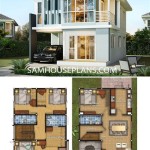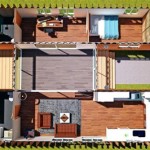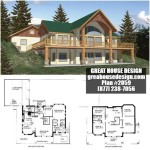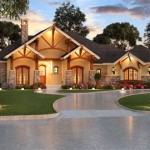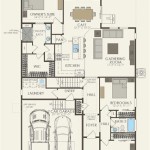French Chateau Style Home Plans: A Comprehensive Overview
French Chateau style home plans evoke a sense of timeless elegance and grandeur, transporting homeowners and visitors alike to the picturesque countryside of France. Characterized by their imposing scale, sophisticated detailing, and historical influences, these designs offer a unique blend of old-world charm and modern functionality. Understanding the key features, historical context, and planning considerations associated with French Chateau architecture is crucial for anyone considering this distinctive style for their dream home.
The French Chateau style, as it is known in modern residential architecture, draws inspiration from the opulent country estates built by French aristocracy primarily during the Renaissance period. These original Chateaux were not merely residences but were symbols of power and status, reflecting the wealth and influence of their owners. Over time, the architectural elements of these grand estates have been adapted and refined for residential use, offering a scaled-down but equally impressive aesthetic for contemporary homes.
Modern French Chateau style home plans typically emphasize a symmetrical facade, steep rooflines, and an abundance of windows, allowing natural light to flood the interior spaces. The incorporation of natural materials such as stone, brick, and stucco further enhances the authenticity of the design. While retaining the charm of historic French architecture, contemporary designs also integrate the latest amenities and technologies for comfortable and modern living.
A successfully executed French Chateau style home plan requires careful consideration of various factors, including site selection, budget constraints, and lifestyle preferences. Understanding the design principles and typical features of this architectural style is essential to ensure that the final product is both visually appealing and functionally sound.
Key Features of French Chateau Style Home Plans
One of the defining characteristics of French Chateau style homes is their emphasis on symmetry. The facade is typically symmetrical, with a central entrance flanked by balanced architectural elements such as windows, chimneys, and wings. This symmetry creates a sense of order and visual harmony, contributing to the overall elegance of the design.
Steeply pitched roofs are another hallmark of the French Chateau style. These roofs are often clad in slate or tile, adding to the visual richness of the exterior. Dormers, which are windows projecting from the roof, are also commonly incorporated, providing additional light and ventilation to the attic spaces. The steep rooflines can also accommodate higher ceilings on upper floors, creating more spacious and comfortable living areas.
Extensive use of stone and brick is characteristic feature of this home design. The exterior walls are often constructed of stone or brick, or a combination of both, to create a sense of solidity and permanence. Stone quoins, which are decorative corner elements, are frequently used to accentuate the corners of the building, adding visual interest and reinforcing the architectural detailing. Stucco, a type of plaster, is also commonly used to create smooth and textured surfaces on the exterior walls.
Windows are a prominent feature in French Chateau style homes. Large windows, often arranged in symmetrical patterns, allow ample natural light to penetrate the interior spaces. French doors, which are double doors with multiple glass panes, are frequently used to connect the interior spaces with the outdoor areas. These doors not only provide access to patios and gardens but also enhance the aesthetic appeal of the home.
Many French Chateau style homes feature turrets or towers, which are vertical extensions that add architectural interest and create a sense of grandeur. These towers are often located at the corners of the building and can serve as decorative elements or functional spaces, such as libraries or studies. The presence of a turret or tower immediately elevates the design and contributes to the overall impression of a stately residence.
Elaborate detailing is an important aspect of French Chateau style homes. This detailing can include intricate moldings, decorative carvings, and ornate ironwork. These details are used to enhance the visual appeal of the home and to create a sense of richness and sophistication. For example, decorative moldings may be applied around windows and doors, while ornate ironwork may be used for balconies and railings.
Historical Context and Influences
The French Chateau style is deeply rooted in the architectural traditions of France, particularly the Renaissance period. During this time, French royalty and aristocracy began constructing grand country estates, or Chateaux, as symbols of their wealth and power. These Chateaux were often inspired by Italian Renaissance architecture, which was characterized by its emphasis on symmetry, proportion, and classical forms. The integration of Italian influences with traditional French building techniques resulted in a unique architectural style that is both elegant and imposing.
The Loire Valley in France is home to many of the most famous and influential Chateaux. Chenonceau, Chambord, and Villandry are just a few examples of the magnificent estates that showcase the distinct characteristics of French Chateau architecture. These Chateaux served as models for later residential designs, inspiring architects and homeowners to incorporate elements of this style into their own homes.
Over time, the French Chateau style has evolved and adapted to suit different climates and lifestyles. In the United States, the style became popular in the late 19th and early 20th centuries, particularly among wealthy industrialists who sought to emulate the grandeur of European estates. Architects such as Richard Morris Hunt and Stanford White played a significant role in popularizing the style in America, designing numerous French Chateau style homes for their affluent clients.
While the French Chateau style has remained popular for many years, it has also undergone various interpretations and adaptations. Modern French Chateau style home plans often incorporate contemporary design elements and amenities, while still retaining the essential characteristics of the original style. This allows homeowners to enjoy the timeless elegance of French Chateau architecture while also benefiting from the convenience and comfort of modern living.
Planning Considerations for French Chateau Style Home Plans
Designing and building a French Chateau style home requires careful planning and attention to detail. One of the first considerations is the site selection. The ideal site for a French Chateau style home is a large, level lot with ample space for the building and surrounding gardens. The site should also offer good views and access to natural light. Given the scale of these homes, it's crucial to ensure that the site can accommodate the building footprint without compromising the surrounding landscape.
Budget is another critical factor to consider. French Chateau style homes are typically more expensive to build than other types of homes due to the complexity of the design and the use of high-quality materials. It is important to establish a realistic budget early in the planning process and to work closely with an architect and builder to ensure that the design is feasible within the allocated funds. Material choices, intricate detailing, and custom features can significantly impact the overall cost.
Lifestyle preferences should also be taken into account when designing a French Chateau style home. The interior layout should be tailored to the needs and preferences of the homeowners. For example, a family with young children may require a large playroom or family room, while a couple who enjoys entertaining may prefer a formal dining room and a spacious living room. The number of bedrooms, bathrooms, and other functional spaces should also be carefully considered. Modern conveniences, such as home theaters, wine cellars, and gourmet kitchens, can be integrated into the design to enhance the living experience.
Energy efficiency is an increasingly important consideration for all types of homes, including French Chateau style homes. Incorporating energy-efficient features, such as high-performance windows, insulation, and HVAC systems, can significantly reduce energy consumption and lower utility bills. Sustainable materials, such as bamboo flooring and recycled-content countertops, can also be used to minimize the environmental impact of the home. Energy-efficient lighting and smart home technology can further enhance the sustainability of the design.
Landscape design plays a crucial role in complementing the architecture of a French Chateau style home. Formal gardens, with symmetrical layouts, manicured lawns, and flowering plants, are often used to enhance the visual appeal of the property. Fountains, statues, and other decorative elements can be incorporated to add a touch of elegance and sophistication. The landscape should also be designed to provide privacy and to create a seamless connection between the indoor and outdoor spaces.
Selecting the right architect and builder is essential for the successful execution of a French Chateau style home plan. The architect should have experience designing homes in this style and should be able to translate the homeowners' vision into a detailed set of plans. The builder should have the necessary skills and expertise to construct the home to the highest standards of quality. It is important to choose professionals who are knowledgeable about the specific challenges and requirements of French Chateau architecture.

Plan 927 553

Castle Luxury House Plans Manors Caux And Palaces In European Period Styles

Castle Luxury House Plans Manors Caux And Palaces In European Period Styles

Ranch Floor Plan 3 Bedrms 2 Baths 2118 Sq Ft 153 2004

European Style House Plan 5 Beds 4 Baths 2403 Sq Ft 72 147 Houseplans Com

Plan 72166 Traditional Style With 3 Bed 2 Bath Car Garage

European House Plan With 4 Bedrooms And 3 5 Baths 6000

Castle Luxury House Plans Manors Caux And Palaces In European Period Styles

French Country Living Room Style Santa Barbara Design Center

French Renaissance Plan 6426

